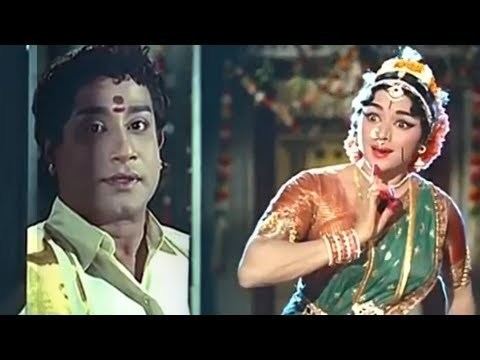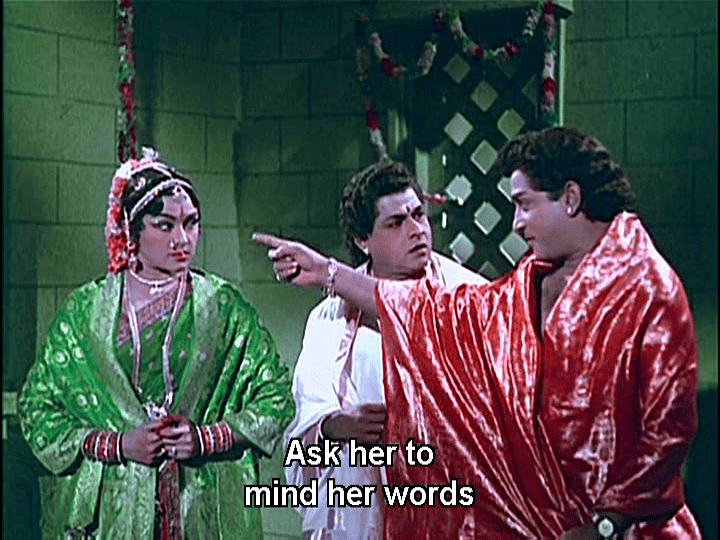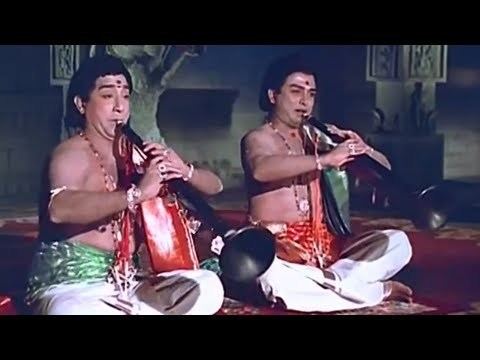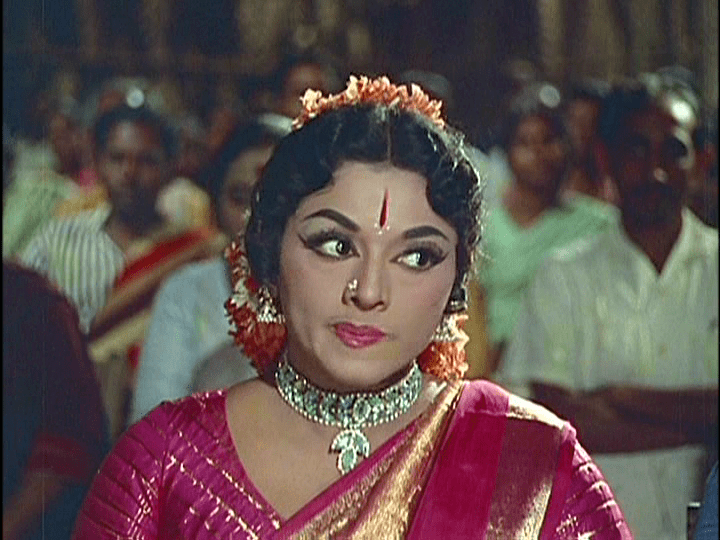Thillana Mohanambal
6.2 /10 6 Votes
Director A. P. Nagarajan Duration | 7/10 IMDb | |||||||||||||||||||||||||||||||||
 | ||||||||||||||||||||||||||||||||||
Release date 27 July 1968 (1968-07-27) Songs Band Music Cast | ||||||||||||||||||||||||||||||||||
Thillana Mohanambal (English: The Dance Queen Mohanambal) is a 1968 Indian Tamil-language musical drama film written, directed, distributed and produced by A. P. Nagarajan. The film stars Sivaji Ganesan, Padmini and T. S. Balaiah in the lead roles, with A. V. M. Rajan, Nagesh and Manorama in supporting roles. It tells the story of about Shanmugasundaram, a nadaswaram player who falls in love with Mohanambal, a Bharatanatyam dancer who reciprocates his feelings, but unfortunate circumstances and their egoistic nature prevents them from confessing their love for one another. How they overcome their self-created obstacles and those created by the people around them forms the rest of the story.
Contents
- Plot
- Cast
- Development
- Casting
- Filming
- Music
- Release and reception
- Critical response
- Accolades
- Legacy
- In popular culture
- References

The film was adapted from Kothamangalam Subbu's novel of the same name, which was serialised in the Tamil magazine Ananda Vikatan in 1957-58. The film was mostly shot in Thanjavur, Thiruvarur and Madurai. Its original soundtrack was composed by K. V. Mahadevan, and songs like "Nalandhana", "Maraindhirundhu" and "Pandian Naanirukka" became immensely popular among the Tamil diaspora.

Thillana Mohanambal was released on 27 July 1968. Critically acclaimed for subtly portraying the socio-cultural environment and the Thanjavur culture of dance and music prevailing at that time, it was also a commercial success, running for over 100 days in theatres. The film won two National Film Awards — Best Feature Film in Tamil (President's Silver Medal) and Best Cinematography — and five Tamil Nadu State Film Awards. Thillana Mohanambal has since acquired cult status in Tamil cinema, and inspired several later films with similar themes of music and dance.

Plot

"Sikkal" Shanmugasundaram (Sundaram) (Sivaji Ganesan) is a devoted nadaswaram player, but is short-tempered and sensitive. He meets Mohanambal (Mohana) (Padmini), a Bharatnatyam dancer, and they fall in love with each other. Sundaram's ego prevents him from developing his relationship with Mohanambal, who asks him to play a Thillana on his Nadaswaram while she dances. Mohanambal's mother Vadivambal (C. K. Saraswathi), an influential and mercenary woman, wants her daughter to marry a wealthy man so that she can settle down in life properly. Blinded by love, she disobeys her mother, creating a rift between them. Unaware of her feelings, Sundaram decides to leave the country along with Karuppayi (Manorama), a folk dancer whom he considers to be his sister. Mohana calls him a coward and challenges him to stay, which he readily accepts. In a temple, Sundaram plays the Thillana and Mohana dances. Sundaram, impressed with Mohana's performance, crowns her the title "Thillana Mohanambal". Suddenly Nagalingam (E. R. Sahadevan), a landlord who wanted to marry Mohana, turns up to stab Sundaram with a poisoned knife out of jealousy. He came to the temple to kill Mohana.

Sundaram is admitted to hospital but recovers from the incident. Later, he and Mohana meet in a concert programme where they perform, against Mohana's mother's wishes. For his personal gains, "Savadal" Vaithi (Nagesh), a cunning man, befriends the Maharaja of Madhanpur (M. N. Nambiar), who is the programme's chief guest. Vaithi promises to make Mohana the Maharaja's mistress. Vaithi traps Mohana by telling her that the Maharaja has invited Nadhaswaram and Bharatanatyam performers to perform in his palace, and that Sundaram has also decided to attend. Mohana immediately accepts the offer and the two visit Madhanpur. Vaithi treats Sundaram's group badly and Sundaram decides to leave. He sees Mohana visiting the Maharaja's room. The Maharaja asks Mohana to be his mistress. but she rejects his advances and is rescued by the Maharaja's wife, the Maharani. Sundaram decides that Mohana does not love him, despite her repeated denial of the Maharaja's offer. Depressed, Mohana runs away. The Maharaja reveals the truth to Sundaram that Mohana had refused his offer and she only loves Sundaram. Sundaram realises his mistake, and rushes to apologise to Mohana, but sees her trying to hang herself from the ceiling of a room in which she had locked herself. He screams to her to stop and promises he will never doubt her love again. Sundaram breaks the door and saves Mohana. They then get married with the approval of her mother. Vaithi is arrested for his crimes.
Cast


Development
Thillana Mohanambal is based on the novel of the same name, written by Kothamangalam Subbu under the pseudonym "Kalaimani". It was serialised in the Tamil magazine Ananda Vikatan in 1957-58. The story portrayed the relationship between Mohanambal (Mohana), a celebrated dancer, and Shanmugasundaram, a Nadaswaram musician. The illustrations for the novel were done by sketch artist and cartoonist, Gopulu.
S. S. Vasan, who held the rights to the book, initially refused to allow director Nagarajan to make the film because Vasan wanted to make a film adaptation himself. When Nagarajan approached him later, Vasan gave him the rights without any consideration. Nagarajan paid Vasan ₹25,000 (about US$3,300 in 1968), but also went to visit Subbu with an additional ₹10,000 (about US$1,300 in 1968). Subbu declined the money, saying that Vasan had forwarded him the money Nagarajan had paid earlier.
Nagarajan produced the film under his production company, Sri Vijayalakshmi Pictures. K. S. Prasad was in charge of the film's cinematography, M. N. Rajan and T. R. Natarajan jointly handled the editing, and Ganga was the film's art director. R. Rangasamy was Sivaji Ganesan's make-up artist.
Casting
Since the film's protagonist is a dancer, Nagarajan wanted Padmini to play the role. Padmini had retired from films and had settled in the United States with her husband Ramachandran at that time. Nagarajan included her in the film after seeking Ramachandran's permission. A younger artist was suggested instead of Padmini for the film, but Nagarajan refused the suggestion. Padmini's character, Mohanambal, competed with Ganesan's character professionally. Ganesan's character is a Nadaswaram player named Shanmugasundaram. Ganesan attended Carnatic music concerts, and consulted Carnatic musicians in preparation for his role. T. S. Balaiah portrayed Muthurakku, the Thavil player. Tiruvidaimarudur Venkatesan played the instrument Thavil off-Screen for Balaiah. Balaiah had additional training for playing the instrument. Madurai T. Srinivasan played the Mridangam off-screen for the song "Maraindhirundhe Paarkum".
A. V. M. Rajan portrayed Shanmugasundaram's brother Thangarathnam. According to playwright Crazy Mohan, Gopulu's caricature of the character Vaithi in Subbu's novel was similar to Nagesh, who portrayed Vaithi in the film. Manorama played the wildly expressive, loud-talking but tender-hearted folk dancer Karuppayi, who has to contend with living under the shadows of landlords; she changes her identity every now and then to escape from them. In an interview with Maalai Malar, Manorama stated that she was initially nervous acting in front of Ganesan and Balaiah, but Nagarajan assured her that whenever her character appeared she would be the centre of attention, which gave her the confidence to play her role. Serial and theatre artist M. L. Bhanumathi played the nurse who treats Shanmugasundaram. Other supporting actors included K. Sarangkapani, S. Ramarao, M. K. Murthy, Balusundaram, T. N. Sivadhanu, S. R. Dasarathan, Sivasooriyan, Senthamarai, Kallapart Natarajan, Gundu Karuppaiah, Chandranbabu, S. V. Rajagopal, A. M. Maruthappa, Udayachandrika, Ambika and Kalpalatha.
The Nadaswaram played by Ganesan and Rajan was played off-screen by the brothers, M. P. N. Sethuraman and M. P. N. Ponnusamy. Nagarajan had seen the duo performing at a wedding reception in Karaikudi and asked them to come to Chennai. Their rehearsals took place over 15 days in Mahadevan's recording studio in Chennai. Nagarajan then listened to a radio recital by the duo, and was impressed with their rendition of Thyagaraja's Keerthana, "Nagumomu Ganaleni". The Keerthana was later selected as one of the soundtrack instrumentals in the film. After Thillana Mohanambal's release, a Russian delegation met Ganesan in person. They were surprised to hear that he was only acting and not actually playing the Nadaswaram.
Filming
Thillana Mohanambal, shot in Eastmancolor, was filmed in Thanjavur, Thiruvarur and Madurai, in the Cauvery delta. Many of the film's aesthetics were borrowed from Indian theatre, of which Nagarajan was an artist. The competition sequence between Ganesan and Padmini took about nine takes to be filmed. The film presented a mise-en-scène feel, mostly using frontal shots. The actors were lined up to face the camera and deliver their dialogue. Nagarajan, a former employee of the T. K. S. drama company, paid tribute to Shankardas Swamigal—from whom the company had its ancestral roots—by naming a drama company in the film after the company's name. Snippets of the film's behind-the-scenes production were filmed by French film director Louis Malle as a part of his 378-minute, seven-part documentary series, L'Inde fantôme: Reflexions sur un voyage (1969), when he visited Madras (now Chennai).
The film shows the traditions exhibited by courtesans, zamindars in coaches drawn by horses, and palaces that resembled 19th century architecture. The contemporary areas of Madurai and Thanjavur, especially their railway junctions, gave the film a sense of ambiguity that was then very common in Tamil cinema. The film recreated the manner in which the Devadasis were portrayed in the early 20th century, and also depicts the social conditions and the upper class milieu in Thanjavur. Real locations were mixed with the fictional town of Madhanpur, which was ruled by a king portrayed by Nambiar. The film also had undertones of the Chithirai festival.
Music
The film's soundtrack and score were composed by K. V. Mahadevan, while the lyrics were written by Kannadasan. The Instrumental pieces "English Notes" and "Nadaswaram Bit" were originally composed by Muthiah Bhagavathar. After performing them at Ganesan's 42nd birthday celebrations, Ponnusamy and Seetharaman were asked to play them in the film. "Maraindhirundhu" was based on Shanmukhapriya raga. "Nalandhana" was based on Nilamani raga, which closely resembles Shivaranjani raga. The first line of "Nalandhana" was later used in the film Silambattam (2008). Under Mahadevan's supervision, Pugazhendi set the Sangatis for the film's soundtrack and score. The soundtrack was released by the record label Saregama.
The soundtrack received positive reviews from critics. Singer Charulatha Mani wrote for The Hindu on "Nalandhana" that, " ... one can feel the proximity in musicality. The Thavil beats, Nadaswara refrains and the honeyed voice all blend into an inviting melody composed by K.V. Mahadevan." For "Maraindhirundhu" she said, "The nadaswaram and thavil back-ups for this song and the jathi-s give it its typical classical flavour. 'Thooyane mayavaa mayane velava ennai aalum Shanmuga vaa' – these lines represent the ideal confluence of raga, bhava and lyric, a perfect foil to each other." Ashish Rajadhyaksha and Paul Willemen in their Encyclopedia of Indian Cinema, referred to "Nalandhana" as "[a] major song hit". According to film critic Randor Guy, "Nalandhana" became "one of the memorable song sequences with Sivaji Ganesan and AVM Rajan, playing the [Nadaswaram] on screen". P. K. Ajith Kumar of The Hindu stated, "Just as [Susheela] does not need to know the language to sing a song perfectly, we need not know Tamil to enjoy her songs like ... Nalandaana... ( Thillana Mohanambal )".
Release and reception
Thillana Mohanambal was released on 27 July 1968. It was released with English subtitles in overseas countries. The film's release prints were 4,825 m (15,830 ft) long and were contained on 19 reels. The film was shown for six weeks at theatres in Pondicherry, and ran for 100 days in Ganesan's family-owned Shanthi theatre in Chennai. It also completed 100-day runs in theatres in Kovai, Madurai and Trichy, and was eventually shown for 25 weeks.
Thillana Mohanambal was screened in Chennai on 21 April 2010 at the South Indian Film Chamber Theatre for the Dignity Film Festival. In November 2011, it was shown at the International Tamil Film Festival held in Uglich, Russia, alongside Chandramukhi (2005), Sivaji (2007), Angadi Theru (2010), Boss Engira Bhaskaran (2010), Thenmerku Paruvakaatru (2010) and Ko (2011).
Critical response
The film received critical acclaim in India and abroad for its song and dance sequences, humour and portrayal of the prevailing socio-cultural milieu at that time. The performances of the actors were praised. The Tamil magazine Ananda Vikatan carried an 11-page review of Thillana Mohanambal with a discussion among several prominent people, which included IAS officers, professors and actors who unanimously appreciated the film and the people associated with it. The review's conclusion was, "The director should be given a prize for making such a film".
In its original review, The Hindu said, "Thillana Mohanambal encumasses [sic] all the traditional wealth of the culture of [Tamil Nadu]." Subha J. Rao and K. Jeshi of The Hindu, in their article "Laughter lines", praised the train scene and the performances of Balaiah and Manorama. The Hindu in its Cinema Plus feature called the film "a perfect combination of music, dance and humour," while also stating that the film can be enjoyed even today. Randor Guy praised Balaiah's acting in the film, saying, "In one song, the famous Tyagaraja kriti in Abheri, ‘Nagumomu Kanaleni’, Balaiah played the thavil in excellent sync with the background song that was recorded earlier in the studio, revealing how adept he really was with the instrument". C. V. Aravind of The News Minute was also positive towards Balaiah's performance, in addition to those of Thangavelu, T. R. Ramachandran and Sarangkapani. On Manorama's performance, N. Kesavan of The Hindu wrote, "One can never forget her role as 'Jil Jil Ramamani' in "Thillana Mohanambal." She was on a par with Sivaji Ganesan and Padmini in the film with her acting."
The magazine Screen called the film "a brilliantly made entertainer". Dina Thanthi wrote "Not one would not have been mesmerized by the "Thillana" dance sequence". The British newspaper Daily Mail said Thillana Mohanambal is "a feast to the eyes and ears". Subhashini Pathmanathan of Daily News Sri Lanka praised the film's dance and music sequences. Tamil Canadian journalist D. B. S. Jeyaraj wrote for Daily FT that Ganesan's " ... duel over artistic superiority with Padmini, particularly during the 'Nalanthaana?' song sequence" was a scene that "remains etched in [his] memory".
In 2011, film historian S. Theodore Baskaran criticised Thillana Mohanambal for its historical inaccuracies, saying that in the film, a Tamil king was seen wearing a Marathi costume, "The film-makers completely neglect the aspects of dress, jewels and weapons that are depicted in our sculptures. They do not even do basic research."
Accolades
Thillana Mohanambal won two National Film Awards and five Tamil Nadu State Film Awards.
Legacy
Thillana Mohanambal became a cult film for bringing the traditional arts of South India into prominence and achieving more popularity than the novel. It became a landmark film for Sivaji Ganesan. Padmini's titular role become so iconic that the film was identified as her pièce de résistance. She considered Thillana Mohanambal to be the Best Film of her career. The film is notable for catapulting Manorama to stardom. A dialogue, "Enakku anga oru beeda kadai kaarana theriyum (I know a paan shop owner there)", which was spoken by Balaiah, became popular. According to the 2010 book Anna: The Life and Times of C.N. Annadurai by R. Kannan, C. N. Annadurai sister's granddaughter, Kanmani, would enquire about his well-being during his last days by singing the song, "Nalamdhana".
The film became a trendsetter and inspired several later films with similar themes of music and dance – including Karagattakaran (1989), Sangamam (1999), and Kaaviya Thalaivan (2014). In July 2007, S. R. Ashok Kumar of The Hindu asked eight Tamil film directors to list their all-time favourite Tamil films; four of them – C. V. Sridhar, K. Balachander, J. Mahendran and K. Bhagyaraj – named Thillana Mohanambal. In May 2014, C. V. Raghavan, writing for The Hindu, listed Thillana Mohanambal among his top five films. Actress Kavitha Nair, who made her debut with Mudhal Idam (2011), changed her screen name to Mohana because she liked the character. Actor Jayaprakash found the film to be "beautifully made". Tamil comedy actor and writer Crazy Mohan stated that the film made his top ten list, and that there was "excellence in all aspects — screenplay, dialogue, comedy, casting, music and direction. A winning combination, indeed. This gives Thillana Mohanambal its timeless appeal". Scriptwriter-Director Viji of Velli Thirai (2008) fame noted how the film showcased the culture of Thanjavur and that the acting performances and film formed a "complete package". In September 2014, Vijay Sethupathi, in an interview with Sudhir Srinivasan of The Hindu, listed Thillana Mohanambal among his favourite films alongside Ratha Kanneer (1954), Puthiya Paravai (1964) and Rajapart Rangadurai (1973).
The prints of the film in 16 mm format were acquired by the American Cultural Association for their archives to represent quintessential old-world Thanjavur culture, and by universities in the United States for the study of Bharatanatyam and Nadaswaram arts in particular. Thillana Mohanambal is included with other Sivaji Ganesan-starrers in 8th Ulaga Adhisayam Sivaji, a compilation DVD featuring Ganesan's "iconic performances in the form of scenes, songs and stunts" which was released in May 2012. Although film distributor Shanthi Chokkalingam stated in February 2012 that Thillana Mohanambal's remaining prints were "totally damaged", Pradeep Sebastian of Deccan Herald stated in April 2015 that he "recently" saw the film through a restored print. In its obituary for Manorama, The Hindu noted Jil Jil Ramamani "probably bore the closest resemblance to Manorama" in terms of being able to perform Karakattam and Poikkal Kuthirai.
In popular culture
Thillana Mohanambal has been parodied and referenced in many films. In a comedy scene from Karagattakaran, Senthil dances with Kovai Sarala and an onlooker compares them to Ganesan and Padmini's characters from the film, resulting in Goundamani becoming irked by the comment. The Times of India compared Karagattakaran to Thillana Mohanambal because in both films, the male and female lead characters are in love with each other, despite being professional rivals. In the film Villu Pattukaran (1992), Goundamani asks Senthil to play "Nalandhana" on his thavil, resulting in a comical argument between the two. In Muthu (1995), the title character (Rajinikanth), in a conversation with Malayasimman (Sarath Babu), says that Ambalarathar's (Radha Ravi) daughter, Padmini (Subhashri) looks like actress Padmini's character, Mohana, in the film.
When Vadivelu's character Kuzhandaivelu is injured in Middle Class Madhavan (2001), Revathi Sankaran, who plays his in-law in the film, sings "Nalandhana" while enquiring about his health. In Perazhagan (2004), when hunchback Chinna (Suriya) talks about improving his looks, Kuzhandaisamy (Vivek) jokes that if Chinna was given a party horn to play with, he would look like 'Sikkal' Shanmugasundaram. Scenes from Thillana Mohanambal were parodied in Thamizh Padam (2010). The film's poster depicts lead actor Shiva as Ganesan's character, Shanmugasundaram and M. S. Bhaskar as Balaiah's character, Muthurakku.
References
Thillana Mohanambal WikipediaThillana Mohanambal IMDb Thillana Mohanambal themoviedb.org
